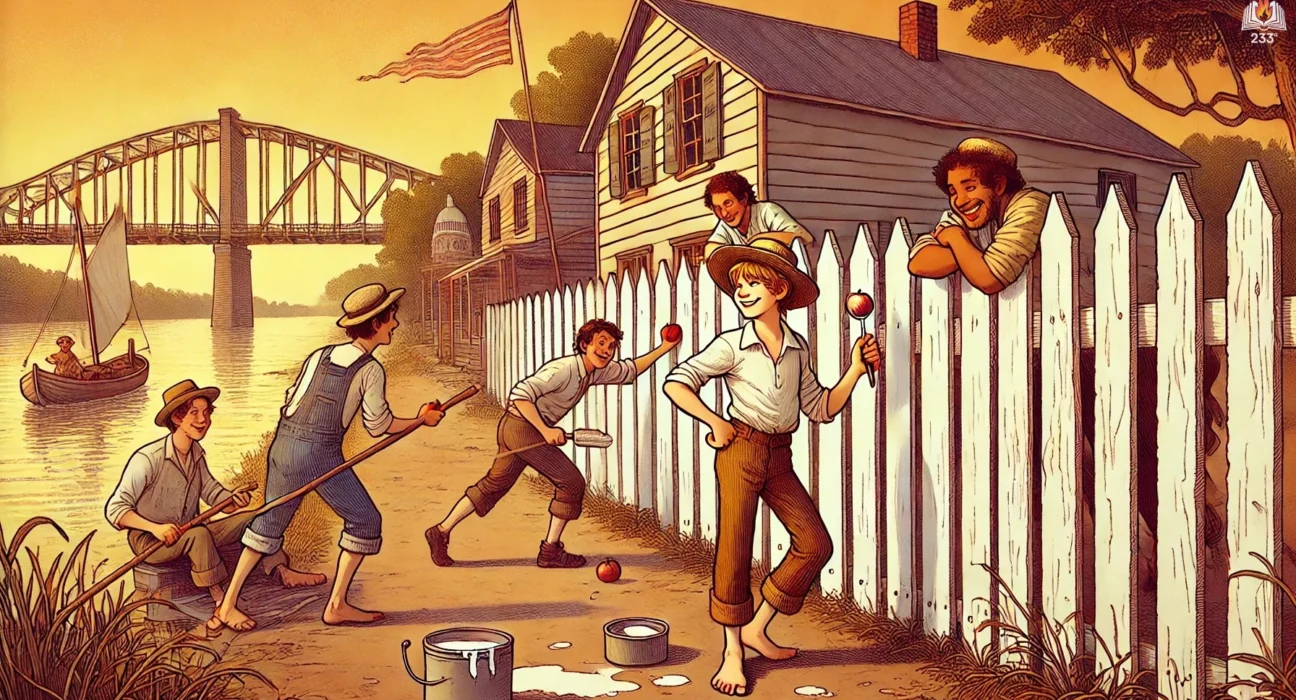The Adventures of Tom Sawyer by Mark Twain (published in 1876) is a beloved classic that captures the spirit of youthful adventure and the charm of life along the Mississippi River during the 19th century. Twain weaves a tale of childhood mischief, exploration, and coming-of-age experiences, providing readers with both humor and reflection. Set in the fictional town of St. Petersburg, the novel follows the imaginative and rebellious Tom Sawyer as he navigates the joys and challenges of growing up.
Plot Summary
Tom Sawyer was a boy of wild imagination, always in search of the next great adventure, in the sleepy town of St. Petersburg, nestled along the mighty Mississippi River. Under the watchful but loving eye of Aunt Polly, Tom was both a source of frustration and joy. From the very start, Tom’s mischievous nature was clear—skipping chores and school at every opportunity to indulge in games and adventures. One Saturday morning, Aunt Polly assigned him the tedious task of whitewashing a fence, but Tom, ever the clever one, tricked his friends into doing the work for him, making it seem like a rare privilege. By the time the fence gleamed with fresh paint, Tom had traded his friends’ labor for their most prized possessions.
Tom’s school days were filled with distraction, but one day his heart was captured by the sight of Becky Thatcher, the new girl in town. Determined to win her affection, he went to great lengths to impress her with his daring antics. Their relationship bloomed through stolen glances and shared secrets, though it faced a trial when Tom accidentally mentioned his previous crush, Amy Lawrence. A devastated Becky distanced herself from him, leaving Tom in a state of regret and longing.
One night, Tom, along with his best friend Huckleberry Finn, a boy who lived a life free of rules and civilization, decided to sneak out to the town’s graveyard to try a new superstition. As they waited under the cover of darkness, they witnessed a horrifying event—Injun Joe, a fearsome man, murdered Dr. Robinson and framed the harmless town drunk, Muff Potter. Terrified, Tom and Huck swore a blood oath to keep what they saw a secret, afraid of Injun Joe’s revenge.
As the trial of Muff Potter drew closer, Tom’s guilt gnawed at him. The thought of an innocent man being punished for a crime he didn’t commit became too much to bear. In a moment of bravery, Tom broke his silence in court, pointing to Injun Joe as the true murderer. Injun Joe, however, escaped through a window, vanishing from sight, leaving the town in both relief and fear.
But life returned to its usual rhythm for Tom. His adventures continued, and soon, a new plan was hatched—to run away. Feeling misunderstood and unappreciated, Tom convinced Huck and their friend Joe Harper to flee to Jackson’s Island. There, they lived like pirates, relishing their freedom, fishing, swimming, and living without care. For a few days, they reveled in their newfound independence, but homesickness and guilt began to creep into their hearts. When they sneaked back to town one night, they learned that their families were grieving, believing the boys had drowned. With a spark of mischief, Tom concocted a plan to return dramatically during their own funeral service, much to the shock and joy of their loved ones.
Tom’s adventures were far from over. Summer brought new opportunities for thrill-seeking, and one of those adventures led Tom and Becky to explore McDougal’s Cave during a school outing. Unbeknownst to them, danger lurked in the shadows. As they ventured deeper into the labyrinth of tunnels, they became hopelessly lost. For days, Tom and Becky wandered the dark, twisting passages, their strength and hope fading. Hunger gnawed at them, and fear gripped their hearts. Just when despair was at its peak, Tom stumbled upon a terrifying sight—Injun Joe was using the cave as a hideout. But luck was on Tom’s side, and he managed to find a way out, guiding Becky to safety just in time.
The discovery of Injun Joe’s presence in the cave soon reached the town, and the cave was sealed off to prevent anyone from entering. Little did they know that this act trapped Injun Joe inside, and days later, his body was found near the cave’s entrance, marking the end of his reign of terror.
The mystery of the cave, however, was not the only treasure to be found. During his time in the cave, Tom had glimpsed something glittering—a hidden stash of gold. He and Huck, driven by curiosity and the lure of riches, returned to the cave. After much searching, they uncovered a fortune that Injun Joe had buried—a cache of gold coins. The boys were now wealthy beyond their wildest dreams.
For Huck, the discovery of treasure brought both joy and discomfort. The newfound wealth made him the target of unwanted attention, especially from the well-meaning Widow Douglas, who took him in and tried to civilize him. But Huck, who had always thrived on his independence, found it hard to live within the constraints of society. He longed for his old life, free from the rules and expectations that came with being “proper.”
As Tom and Huck’s lives took different turns, Tom remained ever the boy of mischief, always dreaming of the next great adventure. He promised Huck that there would be more excitement to come, especially as they toyed with the idea of forming a band of robbers. Though Tom had matured through his experiences, gaining a deeper sense of right and wrong, his thirst for adventure and his knack for turning even the simplest moments into grand exploits remained a constant part of his being.
Through it all, Tom Sawyer remained the heart of St. Petersburg, a boy who chased excitement and freedom, who made mistakes but learned from them, and who, no matter what, faced life with boundless imagination and endless courage.
Main Characters
- Tom Sawyer: The protagonist, a clever and adventurous boy, constantly getting into trouble. He is imaginative, manipulative, and has a thirst for excitement and adventure. Tom’s growth throughout the novel reflects his gradual understanding of responsibility and morality.
- Huckleberry Finn: Tom’s best friend, the son of the town drunk. Huck is carefree and lives outside the bounds of civilized society. Despite his rough life, Huck’s loyalty and honesty shine through his character.
- Aunt Polly: Tom’s loving but strict guardian. She is constantly torn between disciplining Tom and indulging his wild spirit, reflecting the difficult balance of raising a mischievous boy.
- Becky Thatcher: The new girl in town and the object of Tom’s affections. Becky’s interactions with Tom illustrate the emotional ups and downs of childhood infatuation.
- Sid: Tom’s half-brother, a model of good behavior, often used as a foil to Tom’s mischievous nature. Sid’s tattling often gets Tom into trouble.
Theme
- Childhood and Growing Up: The novel explores the experiences of childhood, showcasing the freedom, curiosity, and innocence of young boys. As Tom embarks on his various adventures, he slowly begins to learn the meaning of responsibility and moral choices.
- Social Expectations vs. Individual Freedom: Twain contrasts societal norms with the desire for personal freedom through characters like Tom and Huck. While the adults in St. Petersburg strive for order and propriety, Tom and Huck’s adventures often challenge these expectations.
- Friendship and Loyalty: The bond between Tom and Huck is central to the story. Their loyalty to each other, despite societal judgment and danger, emphasizes the importance of true friendship.
- Superstition and Religion: Throughout the novel, Tom and other characters often rely on superstitions to explain events and shape their understanding of the world, reflecting a blend of ignorance and curiosity in their worldviews.
Writing Style and Tone
Mark Twain’s writing is marked by its humor, wit, and satirical edge. He masterfully captures the dialects and speech patterns of the rural South, making the dialogue authentic and engaging. His narrative voice is lighthearted, often poking fun at the characters and their actions, but there is an underlying critique of the societal norms of the time. Twain’s prose is direct and accessible, making the novel enjoyable for both young readers and adults.
The tone of the novel shifts between playful and serious. While much of the story centers on Tom’s comedic exploits and schemes, there are darker moments, especially as the characters confront real dangers, such as murder and social prejudice. Twain skillfully balances these tones, allowing readers to experience both the joy and peril of childhood.
We hope this summary has sparked your interest and would appreciate you following Celsius 233 on social media:
There’s a treasure trove of other fascinating book summaries waiting for you. Check out our collection of stories that inspire, thrill, and provoke thought, just like this one by checking out the Book Shelf or the Library
Remember, while our summaries capture the essence, they can never replace the full experience of reading the book. If this summary intrigued you, consider diving into the complete story – buy the book and immerse yourself in the author’s original work.
If you want to request a book summary, click here.
When Saurabh is not working/watching football/reading books/traveling, you can reach him via Twitter/X, LinkedIn, or Threads
Restart reading!








